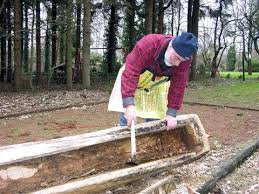A raft can be made by binding floating material together (wood, cane..). It drives, but is not waterproof. It will keep you above water, but not dry.
You can make a big bowl or tub (see <Tubs and barrels >). Which can keep the water both inside and outside. But a vessel is easier to steer and capsize less quickly with a custom, not flat (and heavier) keel.
Braid with sturdy willow twigs a large flat basket and sew hides against it. Then you have a skin boat or corracle. Provide a solid seat, so you can sit stable without burdening the soil on only one point in the middle.
The word 'canoe' comes from the Portuguese / Spanish word “canoa” that Columbus would have entailed from the West Indian Arawaks as a name for it used dugout canoes. In 1955 in the Dutch Pesse a pine wooden canoe was found from 7,000 BC.
 A dugout canoe is made all over the world from a tree trunk. A suitable strain is long and straight enough, with minimal side branches. He is hollowed out by burning off the inner part and / or chop with stone or metal tools, depending on the development and culture. In the Royal Museum for Central Africa in Tervuren you see in the entrance hall a great big canoe where up to 100 people could sit in.
A dugout canoe is made all over the world from a tree trunk. A suitable strain is long and straight enough, with minimal side branches. He is hollowed out by burning off the inner part and / or chop with stone or metal tools, depending on the development and culture. In the Royal Museum for Central Africa in Tervuren you see in the entrance hall a great big canoe where up to 100 people could sit in.
A kayak is a small canoe of which the top is closed, with a manhole or opening in the middle, where the user is sitting with legs forward and fare with a double bladed paddle. So little or no water spatters or waves in it. Originally kayaks were made with a wooden frame, covered with animal skins.
The paddle is a pole with a blade at each end.
In order to make a boat that is wider than a trunk, the wall has to be built up in sections. When clinker construction (mainly from the North (Vikings)) shelves ((lap)strakes) will overlap like roof tiles.
The upper is riveted on the underlying plank with brass or iron nails that turn as a staple, along both sides. Also, a rivet form was used: a nail head with, on the inside folded trough a washer (blank, or ring).
The clinker construction gives the ship a strong exoskeleton structure with a relatively low weight.
When smooth shaped, straight or carvel construction (mainly Mediterranean region) the boards or parts are placed together with the shocking side. They were rejuvenated (chamfered) to get better seam sealing and a larger mounting surface for the clinker or rivet. The seam has already been caulked before the placement of the contiguous skin board (plank). Combined with burnt tree oil tar or pitch, liquefied by heating, a good waterproof and durable hull was created.
One commonly used (previously split with wedges) quarter-sawn oak planks. Irish Quarter sawn wood (split) with the growth rings perpendicular to the width of the board, making the wood wraps little.
Caulking the cracks between the planks is sealed with oakum of a natural fiber (usually hemp) and extracted pitch or tar from trees.
To compress the fibers in the cracks a (wooden) caulking hammer and chisel or iron are used. After that follows covering with pitch or tar.
The swelling of natural fibers absorbing moisture makes a watertight closure.
The craftsmanship exists in putting everywhere the same amount of fibers with a moderate and even pressure. Too little material causing leaks, too much in a place could with moisture absorption even hull to buckle.
Also moss was pressed into the cracks and kept with slats or twigs and iron hooks (embers) in place. Plumes of cattail were suitable sealing material.
To connect planks together the Romans used many small wooden boards that cross over the seams, were inducted and dowelled, a kind of wooden nails through a piece of wood connection.
You were the only one who survived the shipwreck. How could that be? I missed the boat.
